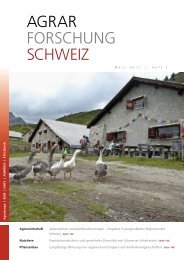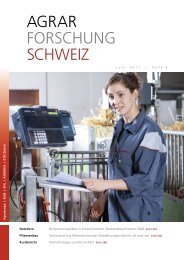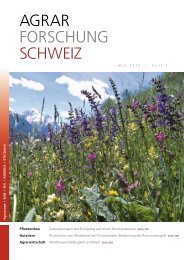Télécharger le PDF - Agrarforschung Schweiz
Télécharger le PDF - Agrarforschung Schweiz
Télécharger le PDF - Agrarforschung Schweiz
You also want an ePaper? Increase the reach of your titles
YUMPU automatically turns print PDFs into web optimized ePapers that Google loves.
Riassunto<br />
Influenza della durata dell'intervallo<br />
tra prelievo di campioni e analisi sulla<br />
carica batterica del latte<br />
Ogni mese, circa 1000–1200 fornitori di<br />
latte dispongono soltanto di un unico<br />
risultato d’analisi anziché di due, come<br />
prevedono <strong>le</strong> basi <strong>le</strong>gali relative al<br />
controllo del latte. L’assenza di una<br />
parte dei valori è da associare al fatto<br />
che in alcuni centri di raccolta la<br />
fornitura di latte avviene a volte ogni<br />
due giorni. Se la data di consegna non<br />
corrisponde alla data dell’ordine di<br />
prelievo e quindi alla raccolta di<br />
campioni, il prelievo non può essere<br />
effettuato. Abbiamo costatato che con<br />
l’incremento dell'intervallo massimo<br />
tra prelievo di campioni e inizio del<strong>le</strong><br />
analisi da 30 a 36 ore si può risolvere il<br />
prob<strong>le</strong>ma in maniera semplice ed<br />
economica. Ciò comporta soltanto un<br />
lieve incremento, compreso tra il 0,07 e<br />
l’1,25 per cento, dei campioni per i<br />
quali vengono pronunciate contestazioni.<br />
La proporzione di risultati che<br />
portano ad una contestazione è infatti<br />
di 1,397 % con un intervallo di 30 ore e<br />
di 1,468-2,648 % con un intervallo di<br />
36 ore. Ta<strong>le</strong> svantaggio può essere<br />
considerato accettabi<strong>le</strong> e si riferisce<br />
solo ai risultati già relativamente vicini<br />
alla soglia di contestazione. Dovrebbe<br />
essere ulteriormente ridotto dall’effetto<br />
d’appiattimento della media<br />
geometrica, la qua<strong>le</strong> è determinante<br />
per la valutazione della qualità<br />
disciplinato dal diritto pubblico.<br />
Bibliographie<br />
b Berger T., 2010. Questionnaire on the Determination of total bacterial<br />
count in raw milk in European Member States. EU Reference Laboratory<br />
on Milk and Milk Products, 4 p.<br />
b Berger T. & Luginbühl W., 2011. Qualitätskontrolldaten Rohmilch (Dezember<br />
2010) – Données du contrô<strong>le</strong> de la qualité du lait cru (décembre<br />
2010). Mail vom 03.02.2011.<br />
b Bühlmann G., Aebi R. & Glättli H., 1999. Wie PetriFoss und BactoScan<br />
8000 die Keimbelastung von Hofabfuhr-Milch je nach Lagerungszeit und<br />
Temperatur beurtei<strong>le</strong>n. Interner Bericht 37/1999, Forschungsanstalt für<br />
Milchwirtschaft FAM, 50 p.<br />
Influence du délai d’analyse des échantillons de lait sur <strong>le</strong> nombre de germes totaux | Aliments<br />
Summary<br />
Influence of the storage period between<br />
sampling and analysis on total bacterial<br />
count in milk<br />
Every month, only one official milk-testing<br />
result is availab<strong>le</strong> from between 1000 and<br />
1200 milk producers instead of the two<br />
required. Of the missing results, one part<br />
originates from milk-col<strong>le</strong>ction centers<br />
where milk delivery takes place every other<br />
day and sampling is performed manually,<br />
and is therefore attributab<strong>le</strong> to the time<br />
delay between sampling notification and<br />
milk delivery. Extending the maximum time<br />
allowed between sampling and commencement<br />
of the analysis from 30 to 36 hours<br />
would provide an easy and cost-effective<br />
method to solve this prob<strong>le</strong>m. The increase<br />
in the number of samp<strong>le</strong>s with results<br />
above the maximum permitted limit would<br />
be slight: In the present study, the percentage<br />
increased from 1,397 % at 30 hours to<br />
1,468 – 2,648 % at 36 hours, representing a<br />
rise of 0,07 – 1,25 %. This can be accepted<br />
as a justifiab<strong>le</strong> drawback as it would affect<br />
very few producers and only those whose<br />
milk at 30 hours contains bacterial counts<br />
close to the official limit. The overall<br />
discrimination would probably be even<br />
lower as the increased time span would not<br />
necessarily affect both monthly samp<strong>le</strong>s<br />
and therefore, after calculation of the<br />
monthly geometric mean as required by the<br />
public-law milk quality control, the results<br />
may well remain within the limits set.<br />
Key words: total bacteria count, milk,<br />
sampling, extension of storage period.<br />
b BVET, 2010. Technische Weisung für die Durchführung der Milchprüfung.<br />
14. März 2011, 13 p.<br />
b Gerber D., Bühlmann G., Seelhofer N., Thür<strong>le</strong>mann P., Berger T. & Jakob<br />
E., 2007. Der MIBD - Rückblick auf eine zehnjährige Pionier<strong>le</strong>istung.<br />
<strong>Agrarforschung</strong> 14 (10), 496–501.<br />
b Glodé M., Gehrig P. & Falk M., 2011. Milchprüfung ändert auf 2011. Information<br />
BVET, 20.10.2010, 2 p.<br />
b Pittet G., 2011. Kostenschätzung zusätzlicher separater Sammeltouren<br />
bei Sammelstel<strong>le</strong>n mit zweitägiger Anlieferung. Information Suisselab,<br />
Sitzung Milchprüfungskomission, 9. September 2011, 2 p.<br />
Recherche Agronomique Suisse 3 (7–8): 390–395, 2012<br />
395
















